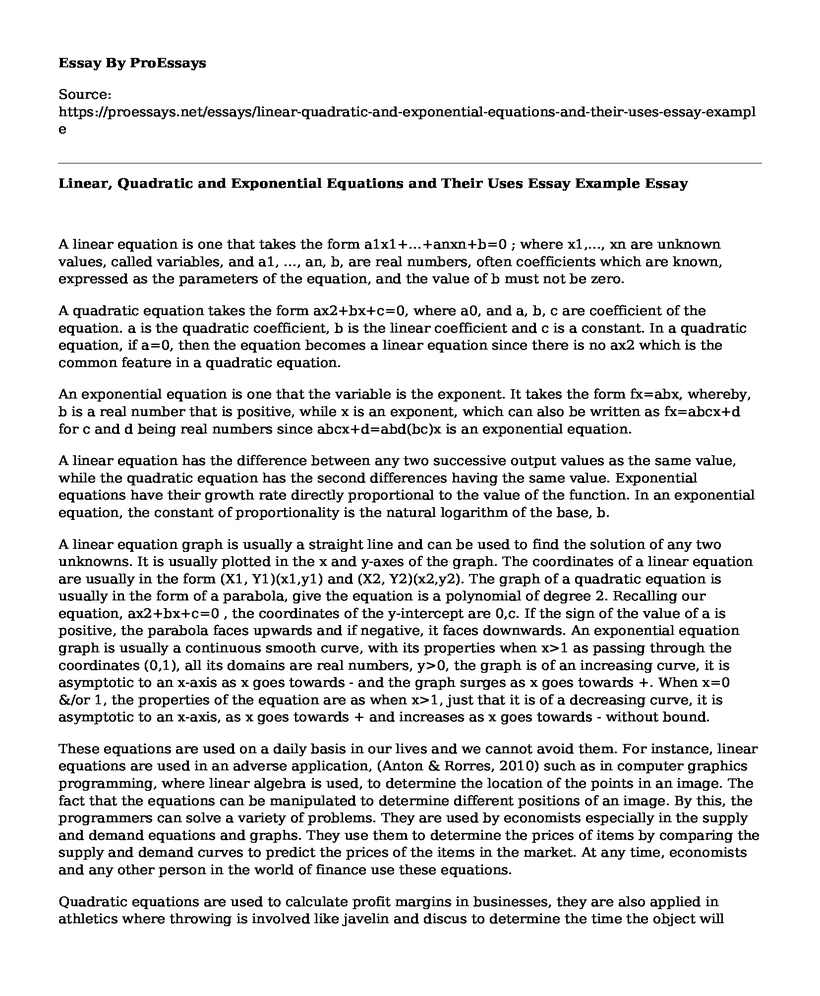A linear equation is one that takes the form a1x1+...+anxn+b=0 ; where x1,..., xn are unknown values, called variables, and a1, ..., an, b, are real numbers, often coefficients which are known, expressed as the parameters of the equation, and the value of b must not be zero.
A quadratic equation takes the form ax2+bx+c=0, where a0, and a, b, c are coefficient of the equation. a is the quadratic coefficient, b is the linear coefficient and c is a constant. In a quadratic equation, if a=0, then the equation becomes a linear equation since there is no ax2 which is the common feature in a quadratic equation.
An exponential equation is one that the variable is the exponent. It takes the form fx=abx, whereby, b is a real number that is positive, while x is an exponent, which can also be written as fx=abcx+d for c and d being real numbers since abcx+d=abd(bc)x is an exponential equation.
A linear equation has the difference between any two successive output values as the same value, while the quadratic equation has the second differences having the same value. Exponential equations have their growth rate directly proportional to the value of the function. In an exponential equation, the constant of proportionality is the natural logarithm of the base, b.
A linear equation graph is usually a straight line and can be used to find the solution of any two unknowns. It is usually plotted in the x and y-axes of the graph. The coordinates of a linear equation are usually in the form (X1, Y1)(x1,y1) and (X2, Y2)(x2,y2). The graph of a quadratic equation is usually in the form of a parabola, give the equation is a polynomial of degree 2. Recalling our equation, ax2+bx+c=0 , the coordinates of the y-intercept are 0,c. If the sign of the value of a is positive, the parabola faces upwards and if negative, it faces downwards. An exponential equation graph is usually a continuous smooth curve, with its properties when x>1 as passing through the coordinates (0,1), all its domains are real numbers, y>0, the graph is of an increasing curve, it is asymptotic to an x-axis as x goes towards - and the graph surges as x goes towards +. When x=0 &/or 1, the properties of the equation are as when x>1, just that it is of a decreasing curve, it is asymptotic to an x-axis, as x goes towards + and increases as x goes towards - without bound.
These equations are used on a daily basis in our lives and we cannot avoid them. For instance, linear equations are used in an adverse application, (Anton & Rorres, 2010) such as in computer graphics programming, where linear algebra is used, to determine the location of the points in an image. The fact that the equations can be manipulated to determine different positions of an image. By this, the programmers can solve a variety of problems. They are used by economists especially in the supply and demand equations and graphs. They use them to determine the prices of items by comparing the supply and demand curves to predict the prices of the items in the market. At any time, economists and any other person in the world of finance use these equations.
Quadratic equations are used to calculate profit margins in businesses, they are also applied in athletics where throwing is involved like javelin and discus to determine the time the object will reach the destination using the height and speed applied (Qian & Sapatnekar 2005). Exponential equations are applied in exponential growths and decay, like in savings to know how much interest is going to accrue over a period of time, also used to calculate the interests in loans. In chemistry, the rate of decay of radioactive materials is measured exponentially (Fu & Labuza, 1993).
- y=9x+1 is an example of a linear equation.
- x2+4x=10 is an example of a quadratic equation.
- e2x=80 is an example of an exponential equation.
References
Anton, H., & Rorres, C. (2010). Elementary linear algebra: applications version. John Wiley & Sons.
Qin, H., & Sapatnekar, S. S. (2005, November). A hybrid linear equation solver and its application in quadratic placement. In ICCAD-2005. IEEE/ACM International Conference on Computer-Aided Design, 2005. (pp. 905-909). IEEE.
Fu, B., & Labuza, T. P. (1993). Shelf-life prediction: theory and application. Food Control, 4(3), 125-133.
Cite this page
Linear, Quadratic and Exponential Equations and Their Uses Essay Example. (2022, Dec 14). Retrieved from https://proessays.net/essays/linear-quadratic-and-exponential-equations-and-their-uses-essay-example
If you are the original author of this essay and no longer wish to have it published on the ProEssays website, please click below to request its removal:
- Deepwater Horizon Explosion. Essay Sample.
- Questions and Answers on Hydrogen in Metals I-Basic Properties
- Discovering the Universe: Bing Bang Theory, String Theory Paper Example
- The Monty Hall Paradox Essay Example
- Essay on Creating an A3 Map: Crafting an Informative & Understandable Map
- Paper Example on Finite Element Method With Applications in Engineering
- Essay Example on the Pythagorean Theorem: A Pillar of Mathematics.







